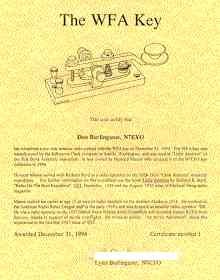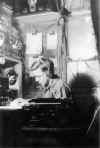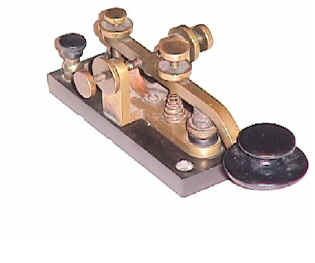The Moto-Key is manufactured and sold by Howard F. Mason, 2709-4th West, Seattle, Wash. -D.H.M.
When I read the product review I remember thinking that it would be wonderful if Mason had named his son "Howard, Junior" and that the son would have some recollection of the Moto-Key. I picked up the Seattle telephone directory and was surprised to see a "Howard Mason" listed. I called the number and asked for Mr. Mason, and the lady that answered told me that he was taking a nap. I (as casually as I could) asked her if her husband had manufactured a telegraph key in the 1930's, and she chuckled and told me "Howard never did much with that". I nearly had coronary arrest! I talked to him later in the day, and visited the following day.
Howard was delighted to have the company, and happily showed me the Moto-Key. He manufactured a total of three of them. The first was sold to a radio operator in Bremerton, Washington who used it at the Navy station. Its whereabouts are unknown. The second was sold on August 31, 1992 to me. The Moto-Keys were not serially numbered or otherwise marked.
Mason stated that at the time of production that he was employed by the Puget sound Naval Shipyard in Bremerton, Washington. He designed and built the Moto-Key at his home at the above listed address. He had the aluminum base cast at a foundry in Ballard, Washington, and did all of the machine work on the rest of the key. He purchased the gears in the key from the Boston Key company.
At the time of my visit Mr. Mason was 91 years old, and to say that he has led an interesting life would be a gross understatement! He was born in Indiana, and after the death of his father his family moved to Eagle Harbor, Washington when he was five years old. He had an early interest in radio and was licensed as an amateur radio operator [7BK] in 1917. In the early 1920's he worked on the American Radio Relay League Staff, and knew Hiram Percy Maxim.
Mr. Mason served as a radio operator in the 1927 Detroit News Wilkins Arctic Expedition from February 28, 1927 to June 5, 1927. During this expedition he operated station KFZG from Barrow, Alaska in support of Arctic overflights. [See: "An Arctic Adventure", by Howard F. Mason, QST magazine October, 1927]
He served with Richard Byrd as a radio operator in the 1928-1930 "Little America" Antarctic expedition. Prior to leaving New York on the expedition he worked at the lighthouse depot on Staten Island building the transmitters that were used on the expedition. [See: "Radio On The Byrd Expedition", QST, December, 1928] He also built three battery operated trail sets for portable use in Antarctica. There were 42 men on the expedition, and prior to being selected they took a battery of examinations to determine if they were mentally suitable for the trip.
Mr. Mason had photographs of the Little America Station that show two telegraph keys. One of the keys, a Vibroplex #6 or "lightning bug" can clearly be identified. It was owned by Malcolm P. Hanson.
The other key is a Kilbourne & Clark spark straight key that was still owned by Mr. Mason. The Kilbourne-Clark key was used by Radio Operator Carl Peterson to send the radio message from radio WFA to radio WHD [the New York Times] announcing to the world that Commander Byrd has crossed the South Pole by air. Mason bought this key in the mid 1920's from Mr. Howard Pyle, a friend that he happened to meet on a street car in Seattle, Washington. Mason used this key on the Antarctic expedition and as a radio operator at the Union Bay cannery and the Nakat cannery in Alaska. Prior to his death Mason gave me the key for my collection. I use it as a station key since I feel that it would be wrong to take it off the air after all of these years. I named it the "WFA Key" because WFA was the call sign used by the Little America expedition.I have printed a certificate commemorating contacts made with this key and issue it in lieu of a QSL card.

UPDATE! In 2018 I donated the WFA Key to the ARRL and it is on display in Newington. Hopefully we will hear it on SKN!



